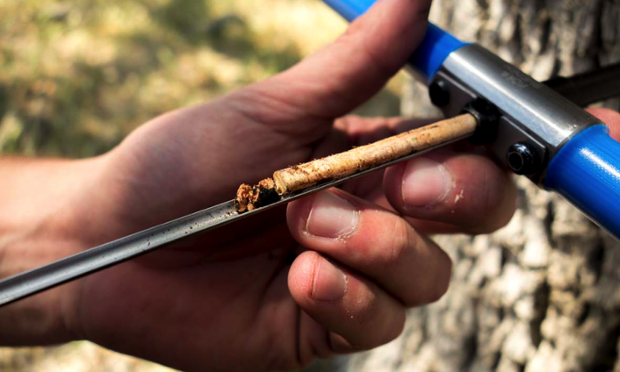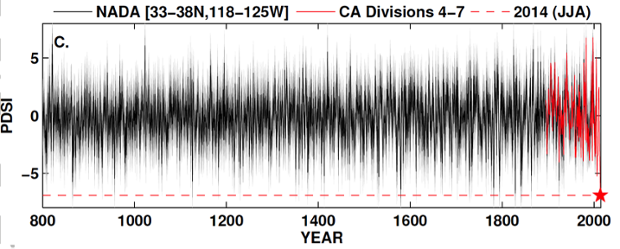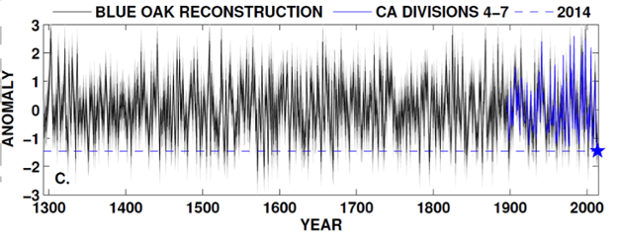 Pencil-like tree-ring cores are collected non-destructively using a Swedish increment borer. May 2014, image by Daniel Griffin.
Pencil-like tree-ring cores are collected non-destructively using a Swedish increment borer. May 2014, image by Daniel Griffin.A new paper published in the journal Geophysical Research Letters by Griffin & Anchukaitis concludes that the 2012–2014 drought in California was its most intense in at least 1,200 years.
The study used drought reconstructions from tree-ring cores, from the North American Drought Atlas (NADA) and from cores Griffin & Anchukaitis collected from blue oak trees in southern and central California. Blue oak tree ring widths are particularly sensitive to moisture changes. According to Griffin,
California’s old blue oaks are as close to nature’s rain gauges as we get
 Pencil-like tree-ring cores are collected non-destructively using a Swedish increment borer. May 2014, image by Daniel Griffin.
Pencil-like tree-ring cores are collected non-destructively using a Swedish increment borer. May 2014, image by Daniel Griffin.
The study compared today’s drought conditions in California to those reconstructed over the past 1,200 years using the Palmer Drought Severity Index (PDSI), an estimate of available soil moisture. The data showed that California is experiencing its most intense drought in over a millennium,
the current event is the most severe drought in the last 1200 years, with single year (2014) and accumulated moisture deficits worse than any previous continuous span of dry years … In terms of cumulative severity, it is the worst drought on record (-14.55 cumulative PDSI), more extreme than longer (4- to 9-year) droughts.
 Long-term (800 to 2014) composite NADA (black line) and instrumental (solid red line) PDSI. The horizontal dashed red line and star indicate the 2014 value. Photograph: Geophysical Research Letters.
Long-term (800 to 2014) composite NADA (black line) and instrumental (solid red line) PDSI. The horizontal dashed red line and star indicate the 2014 value. Photograph: Geophysical Research Letters.
What’s interesting is that the blue oak data showed that while precipitation levels in California have been low over the past 3 years, the levels haven’t been unprecedented.
 Long-term (1293 to 2014) reconstructed (black line) and instrumental (blue line) normalized precipitation anomalies. The dashed blue line and star indicate the 2014 value. Photograph: Geophysical Research Letters.
Long-term (1293 to 2014) reconstructed (black line) and instrumental (blue line) normalized precipitation anomalies. The dashed blue line and star indicate the 2014 value. Photograph: Geophysical Research Letters.
But at the same time as California has been getting little rain, it’s also experienced record hot temperatures. It’s the heat that’s pushed the drought into unprecedented territory. Griffin & Anchukaitis concluded,
temperature could have exacerbated the 2014 drought by approximately 36% … These observations from the paleoclimate record suggest that high temperatures have combined with the low but not yet exceptional precipitation deficits to create the worst short-term drought of the last millennium for the state of California … Future severe droughts are expected to be in part driven by anthropogenic influences and temperatures outside the range of the last millennium.
Another new paper also published in Geophysical Research Letters by scientists at the University of California, Irvine likewise recognizes the extreme and unprecedented nature of California’s current drought, and focuses on the risks that these events pose in the present and future.
Despite the well-recognized interdependence between temperature and precipitation … little attention has been paid to risk analysis of concurrent extreme droughts and heatwaves … We argue that the global warming and the associated increase in extreme temperatures substantially increase the chance of concurrent droughts and heatwaves.
As the authors note, at issue is the fact that humans are causing temperatures to rise. Thus although droughts will always happen naturally, as studies have shown, they’ll become more intense in a warmer world. The combination of dry, hot weather will create bigger risks for Californians.
Climate scientist Michael Mann nicely summarized the ways that humans may have contributed to the current California drought,
In fact, there are at least three different mechanisms that are potentially relevant to the connection between the 2013/2014 California drought and human-caused climate change.
There is (1) the impact of climate change on the pattern of sea surface temperature (SST) off the west coast. One recent study suggests that climate change favors an SST pattern in the North Pacific that increases the incidence of the atmospheric circulation pattern responsible for the current drought.
Then there is (2) the marked decrease in Arctic Sea Ice due to global warming. Studies going back more than a decade show that reduced Arctic sea ice may also favor such an atmospheric circulation pattern. More recent work by Jennifer Francis of Rutgers provides independent support for that mechanism.
Finally, there is (3) the effect of global warming on soil moisture. All other things being equal, warming of soils leads to greater rates of evaporation and drying. This mechanism leads to worsened drought even if rainfall patterns are unchanged.
There’s been some confusion about the human influence on the drought because two studies published this year didn’t find a connection to the lack of rainfall. However, as Mann noted, those studies did not consider the three mechanisms listed above. They were incomplete. On the other hand, two other studies that considered the first factor did find a connection.
A high pressure ridge sitting of California’s coast for several years (known as the “Ridiculously Resilient Ridge” for its persistence) has been a primary factor contributing to the low levels of precipitation. The ridge has pushed storms north of California, leaving the state dry. A study led by Noah Diffenbaugh at Stanford used modeling and statistics to find that these sorts of persistent high-pressure ridges are more likely to sit off California’s coast in the presence of high levels of greenhouse gases in the atmosphere.
Another paper published this year by Simon Wang and colleagues similarly concluded that human-caused global warming is changing conditions in the Pacific Ocean that make these high-pressure ridges off the coast stronger, thus intensifying droughts in California.
Posted by dana1981 on Monday, 8 December, 2014
 |
The Skeptical Science website by Skeptical Science is licensed under a Creative Commons Attribution 3.0 Unported License. |